Related Research Articles

The Flatiron Building, originally the Fuller Building, is a triangular 22-story, 285-foot-tall (86.9 m) steel-framed landmarked building at 175 Fifth Avenue in the eponymous Flatiron District neighborhood of the borough of Manhattan in New York City. Designed by Daniel Burnham and Frederick P. Dinkelberg, and known its early days as "Burnham's Folly", it was completed in 1902 and originally included 20 floors. The building sits on a triangular block formed by Fifth Avenue, Broadway, and East 22nd Street—where the building's 87-foot (27 m) back end is located—with East 23rd Street grazing the triangle's northern (uptown) peak. The name "Flatiron" derives from its triangular shape, which recalls that of a cast-iron clothes iron.

The Fuller Building is a skyscraper at 57th Street and Madison Avenue in the Midtown Manhattan neighborhood of New York City. Designed by Walker & Gillette, it was erected between 1928 and 1929. The building is named for its original main occupant, the Fuller Construction Company, which moved from the Flatiron Building.

The Fred F. French Building is a skyscraper at 551 Fifth Avenue on the northeast corner with 45th Street in Midtown Manhattan, New York City. Designed by H. Douglas Ives along with John Sloan and T. Markoe Robertson of the firm Sloan & Robertson, it was erected in 1927. The building is named for Fred F. French, owner of the Fred F. French Companies, for whom the structure was commissioned.
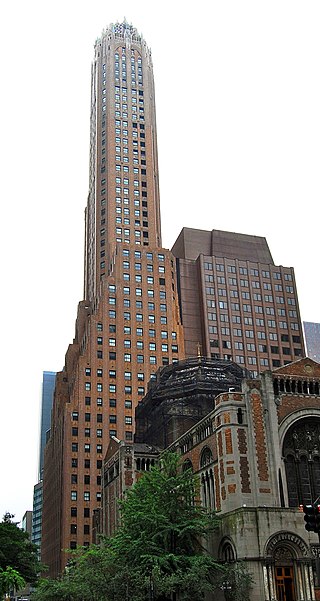
The General Electric Building is a skyscraper at the southwestern corner of Lexington Avenue and 51st Street in Midtown Manhattan, New York City. The building, designed by Cross & Cross and completed in 1931, was known as the RCA Victor Building during its construction. The General Electric Building is sometimes known by its address to avoid confusion with 30 Rockefeller Plaza, which was once known as the GE Building.

34th Street–Penn Station is an express station on the IND Eighth Avenue Line of the New York City Subway, located at the intersection of 34th Street and Eighth Avenue in Midtown Manhattan. It is served by the A and E trains at all times, and by the C train at all times except late nights. The station is adjacent to Pennsylvania Station, the busiest railroad station in the United States as well as a major transfer point to Amtrak, NJ Transit, and the Long Island Rail Road.
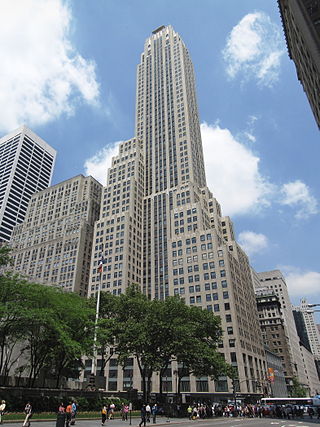
500 Fifth Avenue is a 60-story, 697-foot-tall (212 m) office building on the northwest corner of Fifth Avenue and 42nd Street in Midtown Manhattan, New York City. The building was designed by Shreve, Lamb & Harmon in the Art Deco style and constructed from 1929 to 1931.
The Prudence Building, or Prudence Bonds Building, was a fourteen-story edifice at the southeast corner of Madison Avenue and 43rd Street, in Midtown Manhattan, New York City. It was the headquarters of the Prudence Bonds Corporation, opening in October 1923. Stores on the street level were leased to affluent shops. The banking floor was a close likeness of the Bankers Trust Company building at the southeast corner of Fifth Avenue and 42nd Street. The Bank of Manhattan was accorded a 21-year lease and moved its headquarters from 40 Wall Street. The building was demolished in 2016 and the site is now the location of One Vanderbilt.
590 Madison Avenue, also known as the IBM Building, is a skyscraper at 57th Street and Madison Avenue in the Midtown Manhattan neighborhood of New York City. Designed by Edward Larrabee Barnes and Associates the 41-story, 603-foot (184 m)-tall tower was developed for the technology company IBM and built from 1978 to 1983.
The Gunther Building was a seven-story commercial edifice in Manhattan located at 391 - 393 Fifth Avenue, between 36th Street and 37th Street. It occupied a plot 41.8 feet (12.7 m) on Fifth Avenue by 111.8 feet (34.1 m) in depth. Built in 1909, the establishment conformed in architecture, appointments, and construction with the Tiffany and Company Building, which adjoined it. The latter structure was designed by Stanford White and was constructed by Tiffany & Company in 1903, at the corner of the block on 37th Street.
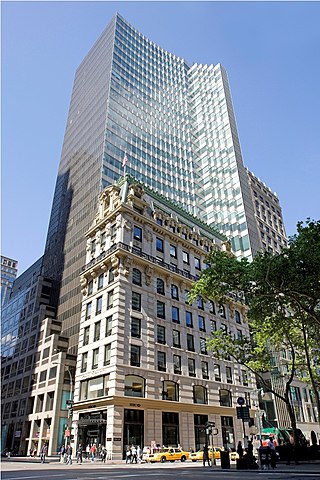
452 Fifth Avenue is an office building at the southwest corner of Fifth Avenue and 40th Street in the Midtown Manhattan neighborhood of New York City. The building includes the 30-story, 400-foot (120 m) HSBC Tower, completed in late 1985 and designed by Attia & Perkins. The 10-story Knox Building, a Beaux-Arts office building designed in 1902 by John H. Duncan, is preserved at the base of the skyscraper. 452 Fifth Avenue faces Bryant Park immediately to the north.

The Ritz Tower is a luxury residential building at 465 Park Avenue on the corner of East 57th Street in the Midtown Manhattan neighborhood of New York City. It was built from 1925 to 1926 as an apartment hotel and was designed by Emery Roth and Thomas Hastings for journalist Arthur Brisbane, who was the developer. The Ritz Tower is about 541 feet (165 m) with 41 stories, making it the tallest residential building in New York City upon its completion. Because it was initially classified as an apartment hotel, the building was constructed to a greater height than was usually permitted.

390 Fifth Avenue, also known as the Gorham Building, is an Italian Renaissance Revival palazzo-style building at Fifth Avenue and West 36th Street in the Midtown Manhattan neighborhood of New York City, United States. It was designed by McKim, Mead & White, with Stanford White as the partner in charge, and built in 1904–1906. The building was named for the Gorham Manufacturing Company, a major manufacturer of sterling and silverplate, and was a successor to the former Gorham Manufacturing Company Building at 889 Broadway. The building features bronze ornamentation and a copper cornice.

608 Fifth Avenue, also known as the Goelet Building or Swiss Center Building, is an office building at Fifth Avenue and West 49th Street in the Midtown Manhattan neighborhood of New York City, adjacent to Rockefeller Center. It was designed by Victor L. S. Hafner for the Goelet family, with Edward Hall Faile as structural engineer. The facade uses elements of both the Art Deco style and the International Style, while the lobby was exclusively designed in the Art Deco style.

2 Park Avenue is a 28-story office building in the Murray Hill neighborhood of Manhattan in New York City. The structure, along the west side of Park Avenue between 32nd and 33rd Streets, was designed by Ely Jacques Kahn and was developed by Abe N. Adelson from 1926 to 1928. The building, known for its facade of brick and colored architectural terracotta, is a New York City designated landmark.

The Madison Belmont Building, also known as 183 Madison Avenue, is a commercial building at the southeast corner of Madison Avenue and 34th Street in Murray Hill, Manhattan, New York. It was designed by Warren & Wetmore in the Neoclassical style and built in 1924–1925. The Madison Belmont Building has a "transitional" design that deviates from Warren & Wetmore's other commissions, combining elements of the Neoclassical style and more modern influences from the Art Deco style.
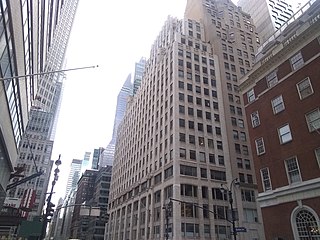
400 Madison Avenue is a 22-story office building in Midtown Manhattan in New York City. It is along Madison Avenue's western sidewalk between 47th and 48th Streets, near Grand Central Terminal. 400 Madison Avenue was designed by H. Craig Severance with Neo-Gothic architectural detailing.

488 Madison Avenue, also known as the Look Building, is a 25-story office building in the Midtown Manhattan neighborhood of New York City. It is along Madison Avenue's western sidewalk between 51st and 52nd Streets, near St. Patrick's Cathedral. 488 Madison Avenue was designed by Emery Roth & Sons in the International Style, and it was constructed and developed by Uris Brothers. The building was originally named for its primary tenant, the American magazine Look.
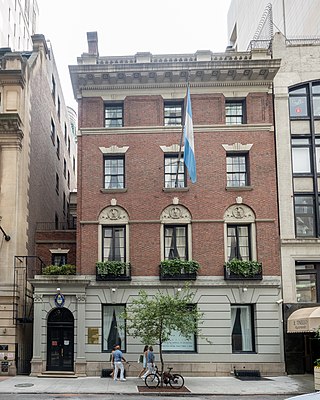
12 West 56th Street is a consular building in the Midtown Manhattan neighborhood of New York City, housing the Consulate General of Argentina in New York City. It is along 56th Street's southern sidewalk between Fifth Avenue and Sixth Avenue. The four-and-a-half story building was designed by McKim, Mead & White in the Georgian Revival style. It was constructed between 1899 and 1901 as a private residence, one of several on 56th Street's "Bankers' Row".

275 Madison Avenue is a 43-story office building in the Murray Hill neighborhood of Manhattan in New York City. It is along the southeast corner of Madison Avenue and 40th Street, near Grand Central Terminal. The building, constructed from 1930 to 1931, was designed by Kenneth Franzheim in a mixture of the Art Deco and International styles.

200 Madison Avenue is a 25-story office building in the Murray Hill neighborhood of Manhattan in New York City. It is along the west side of Madison Avenue between 35th and 36th Streets. Designed by Warren and Wetmore, it was built from 1925 to 1926.
References
- 1 2 "A $1,000,000 Sale". The New York Times . April 23, 1924. p. 36. ProQuest 103297390.
- ↑ "Uptown Trade Movement". The New York Times. February 3, 1924. p. RE2. ProQuest 103293165.
- ↑ "Express Station Campaign Revived". The New York Times. May 18, 1924. p. RE1. ProQuest 103437884.
- 1 2 "New Silk Centre Forming At Madison Avenue And 34th Street". The New York Times. November 23, 1924. p. RE1. ProQuest 103224844.
- ↑ "New Buildings To Cost Millions For The New Silk Trade Centre". The New York Times. January 25, 1925. p. RE1. ProQuest 103683103.
- ↑ "New Silk Centre Lease". The New York Times. June 9, 1925. p. 37. ProQuest 103554418.
- ↑ "Duplan Silk Firm Moves To Broadway". The New York Times. April 19, 1931. p. 152.